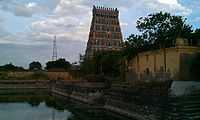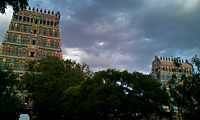Uthirakosamangai
| Uthirakosamangai | |
|---|---|
|
Entrance Vihmana of the temple | |
 Uthirakosamangai Location in Tamil Nadu | |
| Geography | |
| Coordinates | 9°19′N 78°44′E / 9.317°N 78.733°ECoordinates: 9°19′N 78°44′E / 9.317°N 78.733°E |
| Country | India |
| State | Tamil Nadu |
| District | Ramanathapuram |
| Location | Uthirakosamangai |
| Culture | |
| Primary deity | Mangaleswarar(Shiva) |
| Consort | Mangalambigai(Parvathi) |
| Temple tank | Agni |
| Poets | Manickavasagar |
| Architecture | |
| Architectural styles | Dravidian architecture |
Uthirakosamangai (Tamil: உத்திரகோசமங்கை) is a Shaiva temple situated near Ramanathapuram in the Ramanathapuram district of Tamil Nadu.[1] The temple is believed to be built by the Panyda kings, Achutappa Nayak (1529–1542 A.D.), a Hindu ruler of Thanjavur, Muthuveerappar and other kings of Ramanthapuram Sethupathy dynasty at various times.
The temple houses a 6 ft (1.8 m) tall ancient maragatha Nataraja idol carved out of emerald, being the one of its kind. The temple is considered sacred along the lines of Ramanathapuram, Sethu Madhava Theertham and Lakshmana Theertham.[2] The temple has numerous shrines, with those of Mangalanathar, Mangalambigai and Natarajar being the most prominent. The temple has six daily rituals at various times from 5:30 a.m. to 8 p.m., and six yearly festivals on its calendar. The temple is maintained and administered by the Hindu Religious and Endowment Board of the Government of Tamil Nadu. The temple has been glorified by the hymns of 9th-century saint Manickavasagar and 15th-century saint Arunagirinathar.
History
The temple is believed to be built by the Panyda kings. Achutappa Nayak (1529–1542 A.D.), a Hindu ruler of Thanjavur, Muthuveerappar and other kings of Ramanthapuram Sethupathy dynasty have contributed to the temple. The last renovation was carried out by the queen of Ramanthapuram. The temple is maintained and administered by the Hindu Religious and Endowment Board of the Government of Tamil Nadu.[3]
Legend
As per Hindu legend, once hundreds of rishis (ascetics) performed penance worshipping Shiva. Shiva told the rishis that he would appear in the form of a fireball to acknowledge the penance of Mandothari, the wife of Tamil king Ravana in Sri Lanka. Shiva appeared in the form a small child in Ravana's palace. Ravana lifted the beautiful child and there was a small wound out of it. Simultaneously, there was a fireball out of the Agni Theertham (temple tank), which the rishis felt were on account of Shiva attacking Ravana. Out of thousand, 999 killed themselves by falling in the fire, while one of them remained to saved the vedic books. Shiva was pleased by the rishi and appeared as Sahasralingam (thousand lingams) for the 999 and one more for himself in the temple. The single rishi was believed to have emerged later as Manickavasgar in his later birth.[3]
The Temple
The temple is located 32 km East from Paramakkudi and 10 km west from Ramanathapuram. There is a 6 ft (1.8 m) tall ancient maragatha Nataraja idol carved out of emerald inside the temple.[4] The temple has a seven-tiered rajagopuram (gateway tower). There are separate shrines for Mangalanathar (Shiva) in the form of lingam and Mangalambigai. A hall of Saharasralingam has thousand lingams enshrined in it. At the entrance of the main precinct,the temple features exquisite stone carvings of Yali (mythological dragon), depicted with a rolling stone ball inside its mouth. The granite images of the deities Ganesha (son of Shiva and god of wisdom), Murugan (son of Shiva), Nandi (Representative of all our Souls) and Navagraha (nine planetary deities) are located in the hall leading to the sanctum. As in other Shiva temples of Tamil Nadu, the first precinct or the walls around the sanctum of Erumbeeswarar has images of Thenmugaparaman (Dakshinamurthy-Shiva as the Teacher), Durga (warrior-goddess) and Chandikeswarar (a saint and devotee of Shiva).[3]
Worship and festivals

The temple priests perform the puja (rituals) during festivals and on a daily basis. Like other Shiva temples of Tamil Nadu, the priests belong to the Shaiva community, a Brahmin sub-caste. The temple rituals are performed six times a day; Ushathkalam at 5:30 a.m., Kalasanthi at 8:00 a.m., Uchikalam at 10:00 a.m., Sayarakshai at 5:00 p.m., Irandamkalam at 7:00 p.m. and Ardha Jamam at 8:00 p.m. Each ritual comprises four steps: abhisheka (sacred bath), alangaram (decoration), naivethanam (food offering) and deepa aradanai (waving of lamps) for all the deities in the temple. The worship is held amidst music with nagaswaram (pipe instrument), religious instructions in the Vedas (sacred texts) read by priests and prostration by worshippers in front of the temple mast. There are weekly rituals like somavaram (Monday) and sukravaram (Friday), fortnightly rituals like pradosham and monthly festivals like amavasai (new moon day), kiruthigai, pournami (full moon day) and sathurthi. The major festival of the temple are Tirukalyana Vaibhavam (sacred marriage) during the Tamil month of Chittirai (April–May), Vasanthotsavam during Vaigasi (May–June), Pathunal Siva Uthsavam during Aaani (July–August), Annabishekam during Aipasi (October–November), Tiruvathidirai during Margazhi (December–January) and Sivarathri during Masi (February–March). The Tiruvathidirai festival in December attracts a large number of tourists.[3]
Religious significance

The temple is considered sacred along the lines of Ramanathapuram, Sethu Madhava Theertham and Lakshmana Theertham. The emerald image of Nataraja is anointed with sandal paste round the year except on Tiruvathidirai festival day when special worship is practised. It is believed that even small vibrations can damage the image and hence no percussion instruments are used during worship practises. The front hall has lingams made of Padigam (spatika), that are anointed with cooked rice every afternoon. As per Hindu legend, Vishnu and Brahma contested for superiority, Shiva appeared as a flame, and challenged them to find his source. Brahma took the form of a swan, and flew to the sky to see the top of the flame, while Vishnu became the boar Varaha, and sought its base. Neither Brahma nor Vishnu could find the source, and while Vishnu conceded his defeat, Brahma lied with the help of a thazhambu (a type of flower) and said he had found the pinnacle. In punishment, Shiva ordained that Brahma would never have temples on earth in his worship and all Shiva temples do not use thazhambu during worship practises. This is one such temple where thazhambu is still used for worship practises. Manickavasagar, the 9th century Tamil saivite saint poet and nayanar has revered Mangalanathar and the temple in his verses in Thiruvasakam, compiled as the Eighth Tirumurai.Arunagirinathar, a 15th-century Tamil poet has composed Tamil hymns glorifying Murugan in the temple. As per Hindu legend, Muruga was awarded the Airavata (white elephant) of celestial deity Indra at this place.[3]
References
- ↑ http://tnmaps.tn.nic.in/vill.php?dcode=27¢code=0006&tlkname=Ramanathapuram%20%20332706
- ↑ Bandopadhyay, Manohar (2010). Tourist destinations in India. Pinnacle Technology. ISBN 9781618201140.
- ↑ 3.0 3.1 3.2 3.3 3.4 "Thirukoyil". 1 15. Hindu Religious And Endowment Board Tamil Nadu. January 2013. pp. 40–41.
- ↑ "Devotees throng temple at Uthirakosamangai". The Hindu. 2007-01-03. Retrieved 2013-03-31.
External links
| Wikimedia Commons has media related to Uthiragosamangai. |
| ||||||||||||||||||||||||||||||||||||||||||||||